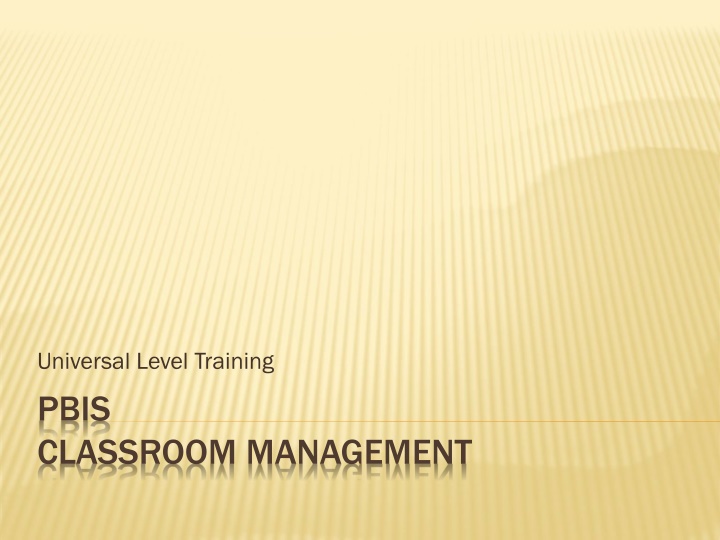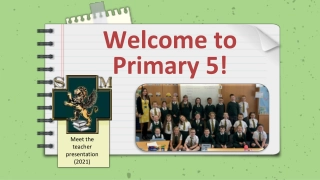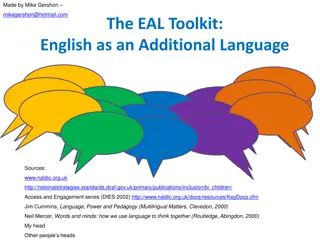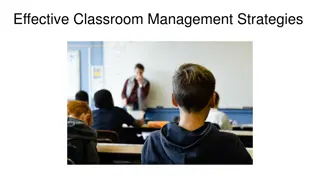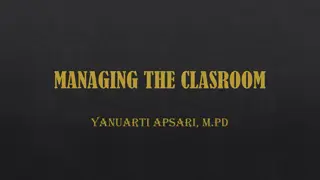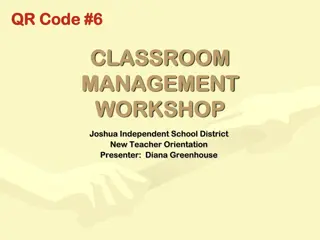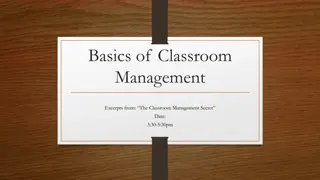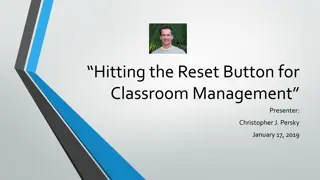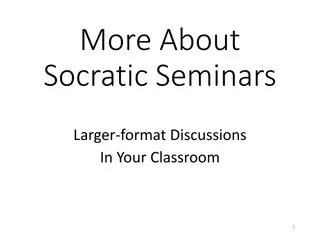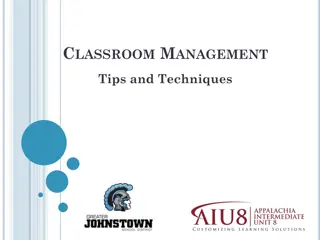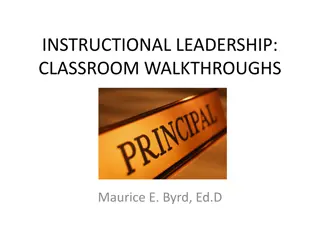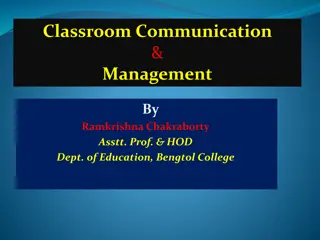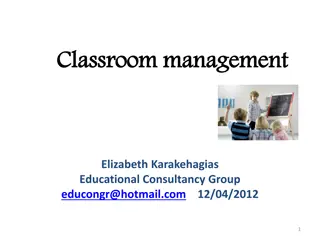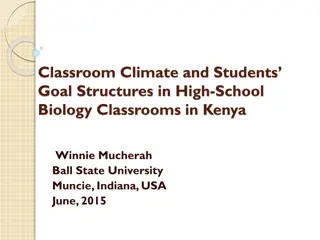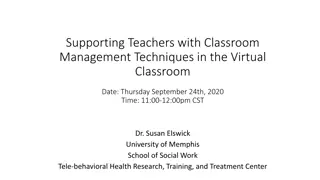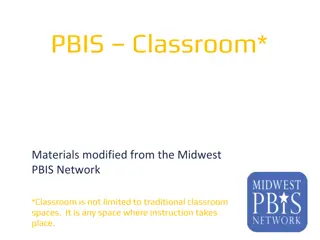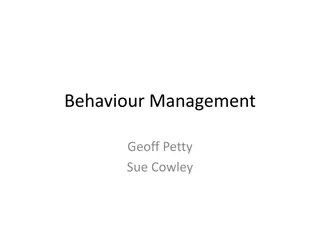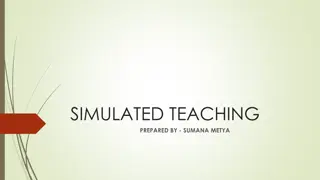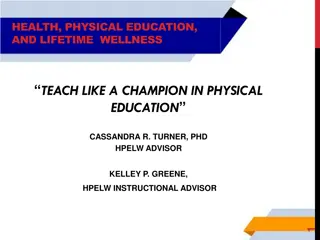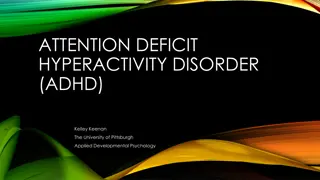Effective Classroom Management Strategies
Effective classroom management strategies play a crucial role in creating a positive learning environment. Implementing school-wide systems, classroom procedures, and behavior expectations can lead to increased student achievement, teacher success, and overall classroom climate. Research shows that well-managed classrooms result in creative instructional delivery, teacher longevity, and successful student outcomes.
Download Presentation

Please find below an Image/Link to download the presentation.
The content on the website is provided AS IS for your information and personal use only. It may not be sold, licensed, or shared on other websites without obtaining consent from the author.If you encounter any issues during the download, it is possible that the publisher has removed the file from their server.
You are allowed to download the files provided on this website for personal or commercial use, subject to the condition that they are used lawfully. All files are the property of their respective owners.
The content on the website is provided AS IS for your information and personal use only. It may not be sold, licensed, or shared on other websites without obtaining consent from the author.
E N D
Presentation Transcript
Universal Level Training PBIS CLASSROOM MANAGEMENT
CLASSROOM PROCEDURES SCHOOL-WIDE SYSTEMS Tier 1 features (school-wide expectations, routines, acknowledgements, in-class continuum of consequences) are implemented within classrooms and consistent with school-wide systems: Staff handbook Informal walk-throughs RTI MODEL
CLASSROOM COMPONENTS Expectations and Rules Routines and Procedures Physical Environment Active Supervision Group Contingencies Specific Praise Opportunities to Respond Error Correction
RESEARCH FOUND. Well managed classrooms are rated as having more positive climates: Teachers experience greater success Increased student achievement Creative and flexible instructional delivery Teacher longevity
FRAMEWORK FOR TEACHING Domain 1: Planning and Preparation Domain 2: Classroom Environment Respect and Rapport, Culture for Learning, Classroom Procedures, Managing Student Behaviors Behaviors, Organizing Physical Space Domain 3: Instruction Domain 4: Professional Responsibilities Managing Student
SELF ASSESSMENT SELF ASSESSMENT Being entirely honest with oneself is a good exercise.
ACTIVITY Before we begin take a few moments to reflect on your classroom and answer these questions: Do my students know my expectations? Do my students know the routines for the classroom? Do my students feel comfortable and safe in my classroom? Do I acknowledge my students good behaviors? Do I know how to handle inappropriate behaviors?
BEHAVIOR EXPECTATIONS Interesting Fact .. Teaching rules, reviewing expectations and providing feedback is associated with an increase in academic engagement, leadership skills and conflict resolution.
CREATING CLASSROOM EXPECTATIONS Staff members should use the School-wide Expectations as the foundation for their classroom expectations. It will be less confusing for the students and should be easy for the teachers to show the connection from the expected school-wide behavior to what is expected in the classroom at all times.
GUIDELINES FOR CREATING CLASSROOM RULES Rules are specific criteria for achieving expectations. They are consistent with School-wide Expectations and meet these guidelines: O = Observable- behaviors that we can see M = Measurable- counting the occurrence of the behavior P = Positively stated- things to do to be successful U = Understandable- student-friendly language A = Always applicable- something the teacher will consistently reinforce
ROUTINES AND PROCEDURES Why focus on Routines and Procedures? When students can predict the events throughout the day, they are more likely to be engaged and less likely to display problem behaviors. One way to increase predictability in a classroom is to establish routines, particularly early in the school year.
PROCEDURES AND ROUTINES SHOULD BE IN PLACE FOR: PROCEDURES AND ROUTINES SHOULD BE IN PLACE FOR: Classroom Activities Getting Students Attention Transitions
CLASSROOM SPACE Mobility and proximity are powerful tools in classroom management Building positive rapport = being approachable Design classroom to minimize distraction and conflict Arrange for easy traffic flow Adequate supervision in all areas Seating arrangements
IMPORTANT REMINDERS Keep high-traffic areas free from congestion Be sure all students can be easily seen and they can see the teacher Make sure that frequently used materials and supplies are readily accessible Be sure students can see instructional presentations and displays
ACTIVITY Draw a diagram on your classroom on the paper provided. Now answer these questions: How many students will you have in the room at one time? Can you group student desks/seats? What kind of activities will be taking place in your classroom and where will they take place? Does the physical arrangement of the classroom maximize the opportunity for positive teacher-student interaction while minimizing the possibility for disruptions? Teacher desk placement? Clutter or teacher view obstructed?
ACTIVE SUPERVISION a process for monitoring the classroom, or any school setting, that incorporates moving, moving, scanning, scanning, and interacting and interacting frequently with students
COMPONENTS OF ACTIVE SUPERVISION Moving Moving: continuous, random teacher movement throughout all parts of classroom Scanning Scanning: frequent and intentional visual sweep of all parts of classroom While moving and scanning you should also frequently interact interact with students Creates positive climate and increases likelihood of accepting correction if needed
ADULT BEHAVIORS THAT MAKE A DIFFERENCE Proximity Listening Eye Contact Smiles Pleasant Voice Tone Touch Use of Student s Name Do Don t
GROUP CONTINGENCIES A group contingency acknowledges students for performing a desired behavior, saves time and resources by designing a program for an entire classroom rather than individual students, and encourages positive social interactions between peers
ADVANTAGES OF GROUP CONTINGENCIES Findings have been favorable across a wide range of behaviors and with a wide range of populations Doesn t single out an individual student in need of intervention Can promote cooperation among students Good opportunity for modeling/role playing and teaching class-wide appropriate behavior
SPECIFIC AND CONTINGENT PRAISE Praise should be . Contingent: Contingent: occur immediately following desired behavior Specific: Specific: tell learner exactly what they are doing correctly and continue to do in the future Good job (not very specific) I like how you are showing me responsibility by wearing your ID (specific)
SPECIFIC POSITIVE FEEDBACK With behavior specific praise (positive feedback) you are recognizing attainment of specified performance criteria, effort, or successes at tasks that are difficult for the child. To ensure continued use, behavior specific praise is essential Whatever you feed, you will grow. Bishop TD Jakes 4:1 4:1
OPPORTUNITIES TO RESPOND A teacher behavior to prompts or solicits a A teacher behavior to prompts or solicits a student response student response OTRs include: Individual or small group questioning: use a pattern to make sure all students are called on Choral response: all students in a class respond in unison to a teacher question Non-verbal responses: students use a signal, writing or movement to respond
The more students spend involved in learning activities, the more they learn. Additionally, increased rates of responding and the subsequent improved learning tend to increase the amount of material that can be covered. When teachers increase their rates of opportunities to respond, student on-task behavior and correct responses increase while disruptive behavior decreases. Use of opportunities to respond (OTRs) includes strategies for presenting materials, asking presenting materials, asking questions, and responding questions, and responding appropriately appropriately to increase the likelihood of an active and desired student response. VALUE OF OTRS VALUE OF OTRS
ERROR CORRECTION A brief, informative statement following the occurrence of an undesired behavior that specifies what the learner should do differently in the future.
DELIVERING ERROR CORRECTION Be calm Be consistent Be specific Be brief Responses should be Immediate And Respectful
EFFECTIVE ERROR CORRECTION STRATEGIES Planned ignoring Physical proximity teacher look Re-teaching rules and expectations Re-direction Verbal warning/reminder Visual cues (hand signals) Private talk with student
IN CONCLUSION Remember today s in-service applies to tier 1 of the PBIS module. It s universal for the 80% that DO NOT require stronger interventions. Take time to reflect upon your practices and your classroom management skills. Complete your action plan for improving your classroom management.
